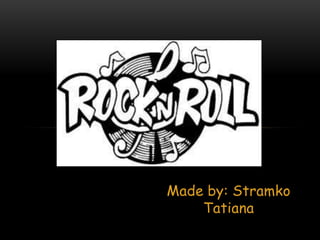
Rock n-roll
- 2. THE HISTORY OF ROCK-N-ROLL • Rock and roll is a genre of popular music that originated and evolved in the United States during the late 1940s and early 1950s, primarily from a combination of African-American genres such as blues, jump blues, jazz, and gospel music, together with Western swing and country music.
- 3. • In the earliest rock and roll styles of the late 1940s and early 1950s, either the piano or saxophone was often the lead instrument, but these were generally replaced or supplemented by guitar in the middle to late 1950s. • Classic rock and roll is usually played with one or two electric guitars (one lead, one rhythm), a string bass or (after the mid-1950s) an electric bass guitar, and a drum kit.
- 4. EARLY ROCK AND ROLL Rockabilly "Rockabilly" usually refers to the type of rock and roll music which was played and recorded in the mid-1950s primarily by white singers such as Elvis Presley, Carl Perkins and Jerry Lee Lewis, who drew mainly on the country roots of the music. Many other popular rock and roll singers of the time, such as Fats Domino and Little Richard, came out of the black rhythm and blues tradition, making the music attractive to white audiences, and are not usually classed as
- 5. DOO WOP • Doo wop was one of the most popular forms of 1950s rock and roll, with an emphasis on multi-part vocal harmonies and meaningless backing lyrics (from which the genre later gained its name), which were usually supported with light instrumentation. Its origins were in African American vocal groups of the 1930s and 40s, like the Ink Spots and the Mills Brothers, who had enjoyed considerable commercial success with arrangements based on close harmonies.
- 6. COVER VERSIONS • Many of the earliest white rock and roll hits were covers or partial re-writes of earlier black rhythm and blues or blues songs. Through the late 1940s and early 1950s, R&B music had been gaining a stronger beat and a wilder style, with artists such as Fats Domino and Johnny Otis speeding up the tempos and increasing the backbeat to great popularity on the juke joint circuit. Before the efforts of Freed and others, black music was taboo on many white-owned radio outlets, but artists and producers quickly recognized the potential of rock and roll. Most of Presley's early hits were covers of black rhythm and blues or blues songs, like "That's All Right", "Baby Let's Play House", "Lawdy Miss Clawdy" and "Hound Dog".
- 7. Far beyond simply a musical style, rock and roll influenced lifestyles, fashion, attitudes, and language. In addition, rock and roll may have helped the cause of the civil rights movement because both African American teens and white American teens enjoyed the music.
